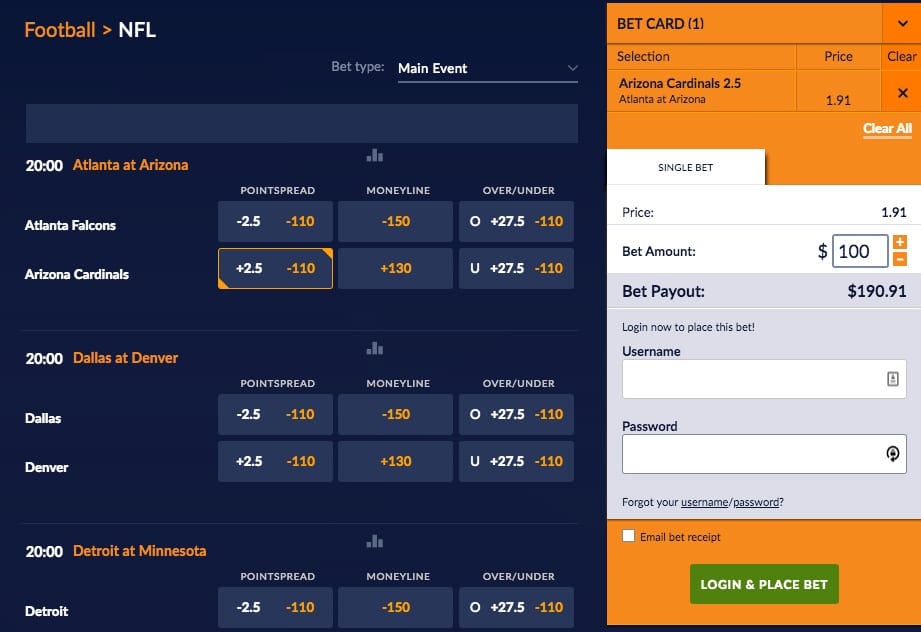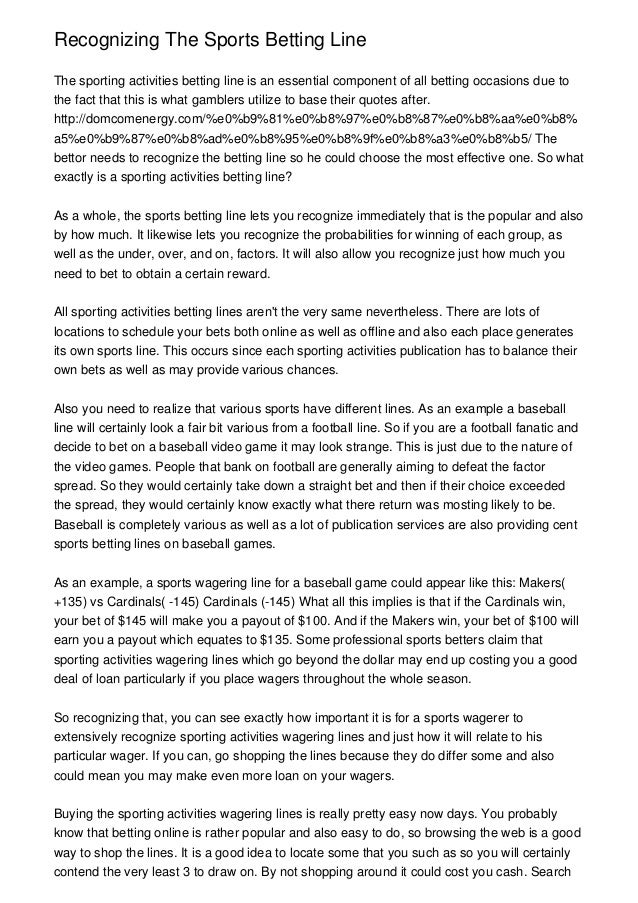What Does The Line Mean In Sports Betting
- What Does The Line Mean In Sports Betting Rules
- What Does Run Line Mean In Sports Betting
- What Does The Line Mean In Sports Betting History
- What Does The Line Mean In Sports Betting Games
- How To Read A Line In Sports Betting
- What Does The Line Mean In Sports Betting Odds


If you do your homework and search across casinos you can find sportsbooks offering what are called ‘reduced juice ’ or ‘nickel lines’. These are lines that the sportsbook will move to a lower “price” of -105. This basically means they’re reducing their commission from 10% to. An abbreviation for “ point spread ” or another term for “ line.” The “spread” is the betting line or odds used to determine the parameters for wagering on either the favorite or underdog in a. What Do the + and – Mean in Sports Betting? The – and + on a sports betting line indicates both your prospective payout and whether you’re betting on the favorite or the underdog. Negative numbers signify the favorite on the betting line. The negative number indicates how much you’d need to bet to win $100. A betting line is a form of wagering whereby the bookmaker or sportsbook set gambling odds and determine the favorite and underdog teams in a match. This handicap creates a margin (line) between the two teams, where there are only two outcomes possible. Sports Betting Odds Explained - Most are completely confused when looking at betting lines for the first time. Loot explains what all the plus and minus signs signify and more! Vigorish Explained - There is a misconception in sports betting that one only has to hit 50% of their bets to break even. Sometimes we forget about the house edge.
How to Read Betting Lines
If your sports betting experience consists mostly of office pools during March Madness or a casual wager between you and a friend while you watch the Super Bowl, the transition to serious sports betting means learning how to read betting lines. The biggest difference between making the kind of casual bets mentioned above and placing wagers with online sportsbooks or at brick-and-mortar bookshops is the use of sports betting lines. Casual wagers usually involve each person in the bet picking one team to win, then wagering an equal amount, say $20 or $30. Professional bookmakers, online sports betting exchanges, and sports betting facilities in casinos have a more complex system for offering wagers on sporting events, in part to ensure profit on the part of the book, and in part to present a standardized representation of odds.
Let’s start with the basics: what do sports bettors mean when they talk about a ‘line?’ The word line, in the language of a sportsbook, can refer to either the odds and/or a point spread in any sports contest. Let’s take a look at an imaginary line the way you’d read it off the board sitting in a Vegas sports betting lounge or on the screen at your online book. Let’s imagine a game between the New York Giants and the Dallas Cowboys. Your book’s NFL betting line might look something like this:
DAL -7.5-110 -405
NYG +7.5-110 +300
56.5 ov-110
What may look like a jumble of words, numbers, and punctuation is actually a precise and easy-to-read breakdown of the various odds and point spread details your book is offering. Here is a breakdown of each unit of information given above. Once you understand each part of the jumbled details above, you’ll be able to read a sports betting line with confidence.
The Point Spread
Obviously, the first three letters on the top two lines of the three-line package of symbols represents a team in the game you’re wagering on; NYG stands for the New York Giants, while DAL stands for the Dallas Cowboys. The number next to each team’s name is known as the spread or the point spread. Wagers on the point spread are among the most popular sports wagers in the world. The reason this wager is popular is that it doesn’t matter which team wins or loses; what matters is the amount of points the teams score, and whether or not the team you place your money on beats the difference in points (the ‘spread’) or not.
Placing a point spread bet means gambling on how much a team will win or lose by. In our above example, the Cowboys are the favorite. How do we know that? The minus symbol in front of the point spread indicates that the bookmaker thinks the final score will have Dallas winning by 7.5 points or more. The underdog, in our example that’s the New York Giants, will always be indicated with a plus sign. If you wager on the Cowboys on the point spread, America’s Team will have to win by at least 8 points for your wager to pay off. Should the Cowboys win by less than 8 points, your bet is lost.
A wager on the Giants on the spread does not mean that New York has to win the game in order for you to win cash. All the G-Men have to do is come within 8 points of the ‘boys, and you’re a winner. You determine a winning or losing point spread by adding or subtracting 7.5 from the final score, depending on which side you laid your bet. If you’re confident that New York will at least come within a touchdown of beating the Cowboys, or beating them outright, then you’d wager on the spread in favor of New York.
A quick word on that annoying half point in the point spread – most lines you’ll come across will use half points, but it’s not standard practice across the board. When you see a line with a full number instead of a number with a half point, your wager could end up as a push. In our example, if the line were 7 instead of 7.5 and the final difference in points was exactly 7, your wager is returned to you, and neither you nor the book makes money.
What’s the function of the second number in the line?
The second number in our example (-110 for both teams) tells you how much you have to wager in order to win $100. It’s an easy way to calculate how much you’ll win if your bet pays off, presented in units of $100 at a time for simplicity’s sake. Most of the time, these two numbers will be the same, because oddsmakers want to set lines so that they get as much action on the underdog as on the favorite, guaranteeing them a profit. If a book gets a single bet of $110 (by a customer hoping to win $100) on the Cowboys and a single bet of $110 on the Giants, it will have taken in $220, but will only have to pay back $210 to whichever customer wins the bet. That’s a guaranteed profit of $10, and since sportsbooks take far more than a single bet in either direction, they stand to earn that seemingly small amount of profit many times over. The $10 difference between what you wager and what you win is known as juice or vig in the sports betting industry, and it’s the way books earn their bread and butter.
What does the last number in the line mean?
The last number in the top two rows of our sports line example is known as the money line. If you’re not interested in betting on the point spread, you can wager on a team to win outright. The plus sign next to the underdog (in our case, the Giants) indicates how much money you’ll earn for every $100 you bet on the money line. Conversely, the minus sign next to the favorite’s line tells you how much you have to wager in order to win $100. In our example, a $100 wager on the Giants earns you $300 should they pull off the upset, while a bet of $405 on the Cowboys will net you an extra $100. Representing odds in units of $100 makes placing different size bets easy; if you want to bet $10 on the Giants, you stand to earn $30 if they win, while a $40.50 bet on the Cowboys will net you an additional $10.
What does the bottom row of numbers and letters mean?
The final line of information in our example line is the over-under. Wagers placed on the over-under have nothing to do with which team wins or the difference between the points they score, but rather the combined number of points both teams will score in the game.
The first number (56.5 in our sample line) is the book’s predicted total score, while the second number (110 in our Giants/Cowboys rivalry game) is how much a punter has to bet in order to win $100. If you were to bet the over-under on this game, you’ll have to decide whether you think the combined score of both teams will be higher or lower than the number put up by the book. Let’s say you bet the over, assuming the game will be a shootout between two talented offenses, you’re hoping that the final score will be anything that totals 57 or more. It could be Dallas 54, New York 3, or any other point combination that adds up to 57 or more and your bet will win. Betting the under means that the two teams cannot score more than 56 points combined, or else you lose your bet.
Reading sports betting lines becomes easier with practice and experience with different sporting events. What looks like a jumble of letters and numbers actually gives a lot of information in a tiny amount of space. Different sports have different types of wagers available, such as the run line in baseball or the puck line in hockey, both of which replace the money line found in our football example. The more experience you have watching and gambling on different sports, the faster you’ll be able to read betting lines.

Welcome to the Sports Betting Odds section of The Sports Geek. If you are new to sports betting and don’t understand how to read betting odds (+150, -110, +2200, etc) we will lay it all out for you and help you learn how the betting odds work.
Betting Site | Bonus | Bet Now | |
|---|---|---|---|
| 1 | up to €30 Free Bet | Go to Site | |
| 2 | 22Bet | 100% up to €122 | Go to Site |
| 3 | 100% up to €200 | Go to Site | |
| 4 | 10Bet | 100% up to €50 | Go to Site |
| 5 | 100% up to €50 | Go to Site |

Sports Betting Odds Explained
Many people don’t know how to read or calculate sports betting odds, so below we have done our best on explaining how betting odds work. The most common type of sports betting odds used in North America are the American style odds which we explain below.
American Style Sports Betting Odds
What Does The Line Mean In Sports Betting Rules
Most online sportsbooks will list their odds in what is called “American Odds”. There are a couple different versions of sports betting odds, but these American Odds are the most common odds used. Reading and understanding sports betting odds can bet a little confusing to beginners, so we have provided an example below using two NFL football teams:
American Odds
- Matchup Odds
- New England Patriots +120
- Pittsburgh Steelers -140
The number shown in the bracket represents the odds. The American Odds have two components to them, the first being the positive or negative sign, and the second being the number that follows the sign.
The sign in front of the number indicates whether placing a wager on that outcome will pay out more money then you have wagered or less money then you have wagered. If the odd is negative (-) it means that outcome is more likely to happen and placing a bet on that outcome would payout less than the amount you wagered, while a positive (+) odd shows that the outcome is less likely to happen and it would pay out more than the amount you wagered.
What Does Run Line Mean In Sports Betting
The next step is figuring out exactly how much the bet pays out, which is where the numbers in the odds come into play.
A listed odd with a – sign in front of it, such as the -140 in our example above, shows us how much money you would need to wager in order to win $100. So using the -140, this would show us that you would need to bet $140 in order to win $100 in profits. You can easily substitute the $100 bet for a $10 bet by moving the decimal place over one spot, showing us that you would need to wager $14 in order to win $10 in profits.
Examples:
A listed odd with a + sign in front of it, such as the +120 in our example above, shows us how much money you would win on a $100 bet. Using the +120 odds, it shows us that a $100 bet on that outcome would pay out $120 in profits. Again this can easily be converted into smaller or larger size bets. A $10 bet on +120 odds would pay out $12 in profits.
Examples:
Below is an example of NFL betting odds taken from an online betting site.
In this example you can see Los Angeles is listed at +130 ($100 bet pays $130 plus of course your original wager back) and New England is listed at -150 ($150 bet pays $100).
The great thing about betting online is that the online sportsbooks will do the calculations for you before you place your bet. You can click on the outcome or team you would like to bet on, and then input the amount you wish to wager and it will show you your potential pay out before you confirm your bet.
Ready To Start Betting?MyBookie and BetUS are my two favorite sportsbooks and make betting very easy. You will also get a Free Money Bonus at each sportsbook if you follow either link above.
What Does The Line Mean In Sports Betting History
Decimal Style Sports Betting Odds
Decimal style odds are used mostly in Europe, and are pretty easy to understand. To calculate the decimal style odds all you will need to do is simply multiply the amount you wish to wager by the decimal odds shown and you will get your payout. For example it may look something like this:
What Does The Line Mean In Sports Betting Games
If you wanted to place a $10 wager on the USA at 2.40 you would simply need to multiply your $10 wager by the 2.40 odds (10 x 2.40) to find out that the payout is $24. It is important to realize that with decimal style odds it includes the amount you wagered, so to find out profits you would need to subtract your wager ($24 – $10) to find out your potential payout is $14 in profits.
How To Read A Line In Sports Betting
If you wanted to place a $10 wager on Brazil you would again just multiply $10 x 1.55 to find out that you would win $15.50 total or $5.50 in profits.
What Does The Line Mean In Sports Betting Odds
Decimal style betting odds are very simple to understand, but you won’t see them displayed in many North American sportsbooks. With that said, most online betting sites will allow you to chose the style of betting odds you want displayed, with American odds set as the default.